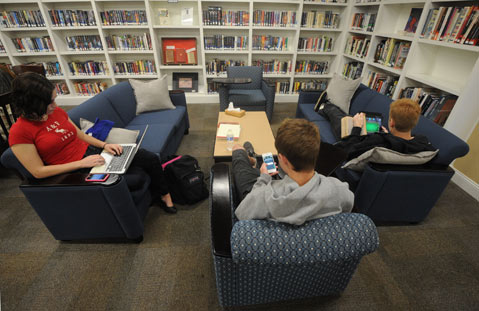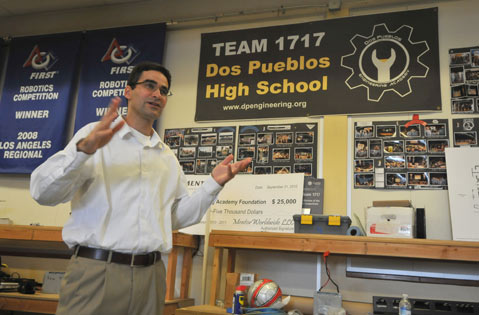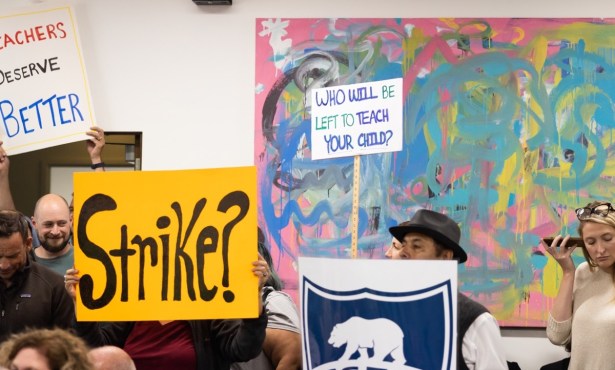S.B. High School Options
Kids Now Can Choose Which High School They Want to Attend

In the past, which color of Converse to buy might have been the biggest decision that high school kids faced; now teenagers (and their parents) must make choices that can carry some serious weight. At the nexus of childhood and pre-adulthood, 8th graders approaching high school must decide which school to attend.
It’s the law for teenagers to go to school, but as populations diversify, so does the traditional school model. Education is not uniform. Choices are plentiful. In fact, schools increasingly “provide the consumer with what they want,” said La Cuesta Continuation High School Principal Frann Wageneck, explaining that the traditional school model was developed in the 1940s and ’50s. Now there are options for those who seek alternatives, in both the public and private realm. Perhaps Ferris Bueller taught us a lesson: Teenagers long to escape the monotony of wooden desks and flat instruction.
“The movement in education right now more closely mirrors the progressive movement. Even Common Core standards are more collaborative and go back to real-world applications,” said John Dewey, current headmaster at Garden Street Academy. Dewey is well versed in various options for Santa Barbara students; his three kids each went to different high schools — Dos Pueblos High School, Bishop García Diego High School, and Garden Street Academy.

His oldest daughter, Isobel Dewey, spent two years at a smaller school before she transferred to Dos Pueblos for the final two. She chalked up the transfer to a desire for a larger, diverse atmosphere. With education in her blood, she’s currently teaching physical science to 9th graders in urban Philadelphia, where choices are not as prevalent as they are in Santa Barbara, she said.
Santa Barbara students have the freedom to choose among varied options for their high school career. From the welcoming entrance at Santa Barbara High School to the manicured mini-campus at Anacapa School, price tags are not the only factors to consider. Throw in the academies within the public school system, alternative/private schools (with some scholarship opportunities), electives, sports, clubs, extracurricular activities, and after-school programs, and the possibilities multiply.
Still, after considering personal preferences, the elimination process ensues, and options do not seem quite as copious. Decisions are often based on several factors including proximity to home, tuition prices ($15,000 to upward of $40,000 for private schools), college prep, specialized programs, class size, religious affiliation, and friends.

In Their Own Words
Speaking to a random sample of public- and private-school students showed that success stories exist for myriad individuals, all of whom wanted different things from their school experience.
Sky Ulep is a senior at Santa Barbara High School who is in the MAD (Multimedia Arts and Design) Academy and created a website during his sophomore year called THINK (The Hazard Is North Korea) to spread awareness that coincided with his history course’s curriculum.
Brittany Tacadena is in the Anger Management class at San Marcos. Tacadena requested to be in the program for a second year because she felt that the small class helped her feel less stressed. It’s more like a support group, she said.
Alec Sherwin is a shy student drawn to Anacapa School because of its close-knit environment. Now in his second year, Sherwin has become friends with much of the student body, and his interest in art has peaked since he started at the alternative school.
Victor Rodriguez is a super-senior at La Cuesta. “I love this school,” he said about the small continuation school made up of 160 juniors and seniors. He prefers it to the bigger public schools because “everyone is friendly and helps you out.” Rodriguez plans to study mechanics next year at Santa Barbara City College.
Luca Jordano is a sophomore who is happy he chose Bishop García Diego because of its tight community and its emphasis on sports and clubs. And Bishop’s faculty get students interested in college during their freshman year, he said. Though it was ultimately his parents’ decision that he attend the Catholic school, he’s glad they pushed for it.
Adrian Rodriguez, a Peabody graduate and now senior at San Marcos, has taken 16 AP and dual-enrollment courses in high school. Rodriguez hopes to attend Tufts University or Amherst College next fall. Like many of his classmates, Rodriguez said he chose San Marcos in part because of its block schedule, where students take three or four 90-minute classes a day.
Misti Gamble decided to go to Laguna Blanca. Although she was initially unsure about the school’s small population, she’s grown to appreciate the one-on-one attention from faculty. Half-Japanese, half-Caucasian, Gamble is currently writing her personal statement about how high school helped her shape a positive self-image after she faced struggles in middle school.
Negin Namavari is an outspoken AVID (Advancement Via Individual Determination) student at Dos Pueblos. The only female in her martial arts program, Namavari had no shortage of positive remarks to share about the environment at DP. “The cheerleader can be friends with the band leader,” she said.
Sophia Tack has an eclectic educational background: After attending Adelante, Santa Barbara, and Olive Grove charter schools, 16-year-old Tack took the CHSPE (California High School Proficiency Exam), left high school, and enrolled in Santa Barbara City College. Coming from a family consisting of doctors and artists and describing herself as equally right- and left-brained, Tack said she has come to appreciate both the structure and freedom of City College.
“I think all of the schools in the city are blessed with resources and good will on the part of the adults,” John Dewey said. Bueller might not need that day off after all.



